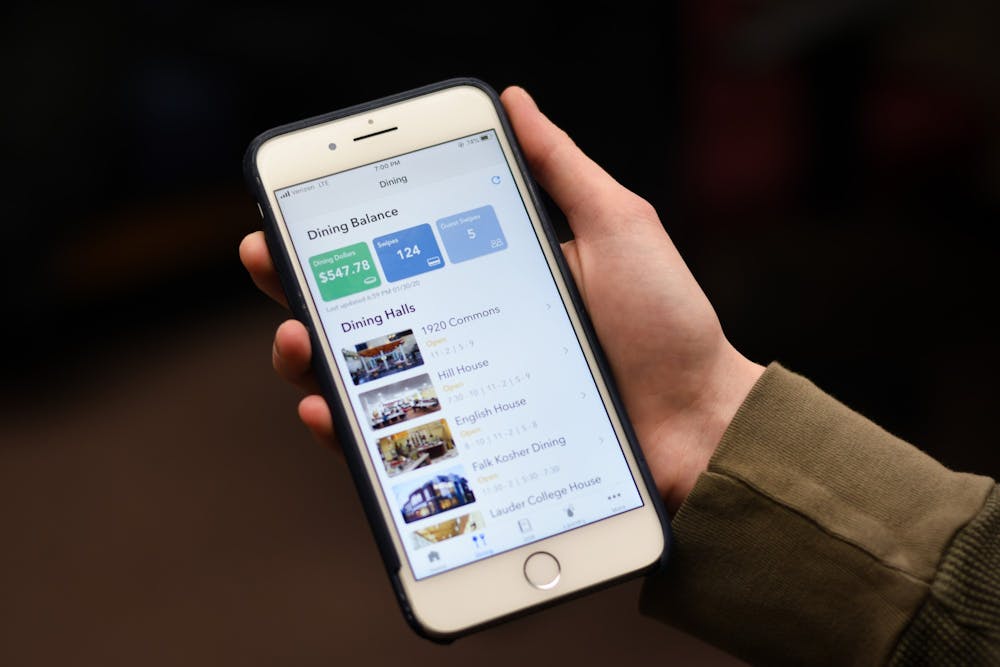Penn Labs added a Dining Analytics feature to its popular Penn Mobile app, aiming to predict when a student will run out of meal swipes or Dining Dollars.
The feature has been in development since fall 2019 and was introduced by Penn Labs, a student software development organization, with an update earlier this month. When accessed through the Dining tab of the Penn Mobile app, the Analytics page displays a graph of previous swipe and Dining Dollar usage along with a line predicting when the student will run out based on their current behavior.
The dining analytics feature relies on an API provided by Penn Dining which transmits data from Campus Express to Penn Mobile. The API tracks real-time student dining balances and a daily history of swipe and dollar expenditures, according to a written statement from Barbara Lea-Kruger, Penn Business Services director of communications and external relations.
“We are always looking for ways to improve the student life with more access to data, and this seemed like a great opportunity,” Wharton and Engineering senior Jong Min Choi, the iOS Team Lead for Penn Mobile, told The Daily Pennsylvanian.
A team including Choi and other current and former Penn Labs members — Dominic Holmes, Josh Doman, Andrew Antenberg, and Hassan Hammoud — developed the feature. Hammoud, a Wharton senior and Penn Labs co-director, said that persuading Penn Dining to provide access to their API required some effort, including a PowerPoint presentation. Members noted that the COVID-19 pandemic also delayed the feature’s deployment.
“The school was pretty receptive, but at first, there was a little bit of hesitancy, in terms of, ‘we’re not sure who you guys are, why do you want this data, and what are you doing with it,'” Hammoud said.
Hammoud added that while Penn Labs has very strict security standards and can’t see any student’s dining balance information, Penn Dining was not initially aware of their security practices, so he had to prove to them that all student data was anonymized and hashed.
Hammoud also analyzed the beginning and end-of-semester dining balances from fall 2019 and found that there were hundreds of thousands of dollars of unused swipes and Dining Dollars caused by students not accurately budgeting their dining plans. He said that by making dining analytics available to students, this six-figure deadweight loss could be reduced.
RELATED:
Student-created app allows users to connect over shared Korean pop culture interests
College Green Ventures co-founders talk about receiving President’s Engagement Prize
Wharton first year Max Chen said he believed the new feature was “really cool” and was prompting discussion among students, but noted an issue where the prediction becomes inaccurate after a student changes their dining plan.
“The projections are completely off because it looks like — I don't know how the regression model works — but basically my dining balance shot down because I changed it, and then my swipes shot up,” Chen said. “So everything’s out of sync.”
Both Choi and Hammoud said that Penn Labs is working on fixing that issue, and encouraged students to submit feedback through the “Share Your Feedback” link in the app.
Currently, the dining analytics feature is only available on iOS. However, according to Choi, Penn Labs is currently working on bringing the feature to Android. Hammoud said that Penn Labs is also considering improving the prediction model to distinguish between weekdays, weekends, and breaks, when swipe and dining dollar usage might change.
Penn Labs released the first version of the Penn Mobile app in 2015 and has since expanded its features to allow students to check their dining balances, see dining hall menus and hours, book study rooms around campus, check on washers and dryers, and more. Other Penn Labs services include Penn Course Review, Penn Course Alert, and Penn Clubs.









